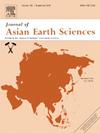Contributions of thermoelastic strain to apparent annual variations in four-component borehole strain: A case study from Gaotai station in the NE margin of the Tibetan Plateau
IF 2.7
3区 地球科学
Q2 GEOSCIENCES, MULTIDISCIPLINARY
引用次数: 0
Abstract
Clarifying the physical mechanisms underlying near-surface annual deformation remains a major challenge in crustal dynamics research. For the four-component borehole strain observation networks in mainland China, a few stations are apparently dominated by annual fluctuations. However, only a limited number of specific studies have been carried out to dynamically assess the physical characteristics of these signals. Considering the fact that atmospheric temperature is a major factor inducing annual variations in crustal deformation, the Gaotai station was thus selected as a typical example diagnosis and a half-space model with a decoupling layer was used to quantitatively assess the thermo-effects of annual atmospheric temperature variation on the four-component borehole strain. The results show that an annual temperature variation with amplitude of 16.60 ℃ can induce a theoretical thermal strain of the 10-6 magnitude at a borehole depth of 44.97 m; additionally, both amplitude and phase of the modeled values closely align with the measured strain time series, suggesting that the annual variation signal of the four-component borehole strain recorded at Gaotai station mainly originates from the annual atmospheric temperature changes. This geodynamical investigation can help to quantitatively elucidate the annual variation mechanism of the multi-component borehole strain and advance our understanding of thermo-deformation processes in shallow crust.

求助全文
约1分钟内获得全文
求助全文
来源期刊

Journal of Asian Earth Sciences
地学-地球科学综合
CiteScore
5.90
自引率
10.00%
发文量
324
审稿时长
71 days
期刊介绍:
Journal of Asian Earth Sciences has an open access mirror journal Journal of Asian Earth Sciences: X, sharing the same aims and scope, editorial team, submission system and rigorous peer review.
The Journal of Asian Earth Sciences is an international interdisciplinary journal devoted to all aspects of research related to the solid Earth Sciences of Asia. The Journal publishes high quality, peer-reviewed scientific papers on the regional geology, tectonics, geochemistry and geophysics of Asia. It will be devoted primarily to research papers but short communications relating to new developments of broad interest, reviews and book reviews will also be included. Papers must have international appeal and should present work of more than local significance.
The scope includes deep processes of the Asian continent and its adjacent oceans; seismology and earthquakes; orogeny, magmatism, metamorphism and volcanism; growth, deformation and destruction of the Asian crust; crust-mantle interaction; evolution of life (early life, biostratigraphy, biogeography and mass-extinction); fluids, fluxes and reservoirs of mineral and energy resources; surface processes (weathering, erosion, transport and deposition of sediments) and resulting geomorphology; and the response of the Earth to global climate change as viewed within the Asian continent and surrounding oceans.
 求助内容:
求助内容: 应助结果提醒方式:
应助结果提醒方式:


